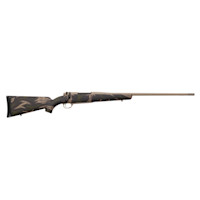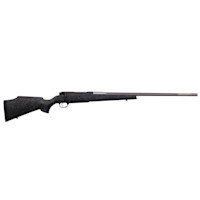
The .223 Remington was designed for the battle, not the field. Militaries want a cartridge that can inflict enough damage to take an enemy off the table, while remaining light and small enough to pack conveniently.
Of course, hunters have adopted a wide array of cartridges originally designed for military use. If the .223 Rem. (or, more accurately, the military’s 5.56 NATO) can take down a combatant, surely it has enough juice to take down a whitetail or a muley.
So goes an age-old debate. Some hunters swear the .223 Rem. is an excellent deer round; others look with horror on anyone would use the cartridge in the field. We’re here to settle that debate. If you’ve ever wondered whether you should take your .223 to the woods, you’ve come to the right place.
.223 Rem. Pro #1: You Might Already Have an AR-15 America’s most popular rifle is an AR-15 chambered in .223 Rem./5.56 NATO. Many Americans purchased these rifles as home-defense guns, for plinking, or for fear of an “assault weapon” ban, but now they wonder whether they can use their black gun to harvest a deer.
It’s an understandable question. Hunting can be expensive, and many folks may prefer to not purchase a new gun just to pursue a new hobby. And during the pandemic, guns and ammo have been famously difficult to find—especially at a reasonable price. For these folks, hunting whitetail or mule deer with a .223 Rem. might be the difference between venison steaks and staying home.
.223 Rem. Pro #2: Shootability Caliber Battle readers will be familiar with this term, and the .223 Rem. is the shootability posterchild. The cartridge is both light on the shoulder and light on the wallet.
The .223 Rem. only produces 2 to 4 foot-pounds (ft.-lbs.) of recoil energy, which is about six times less than a .270 Win. That’s ideal for new and young hunters. Removing the potential for flinching will produce better accuracy in those less experienced or small of stature. Often, a well-placed shot with a lighter bullet is more effective than a bad shot with a piledriver.
The .223 Rem. is also one of the cheapest and most widely available centerfire rifle cartridges on the market, even these days. Cheap FMJ options can be found for about $0.65 per round and quality hunting cartridges run about $2 per round. For comparison, quality 6.5 Creedmoor ammo usually costs about $3 per round (if you can find it).
.223 Rem. Pro #3: Advanced Bullet Technology Bullet design has come a long way since your granddaddy decided a whitetail gun was .30-06 or bust. Ammo makers like Federal, Nosler, and Barnes have developed .223 Rem. loads and projectiles specifically designed for deer hunting, and these companies have full confidence that their products will get the job done.
Federal, for example, includes helpful animal icons on their boxes of ammunition so even inexperienced hunters will know whether a .223 Rem. cartridge can take down a deer. These include the 55-grain Trophy Copper, the 62-grain Fusion MSR, the 60-grain Nosler Partition, and the 62-grain Trophy Bonded Tip.
All these cartridges use projectiles designed to expand and penetrate the vital area of medium-sized game. The cheapest 55-grain plinking bullets may not be able to stay together long enough to penetrate a whitetail’s vitals, especially if it hits any bone along the way. Though hunters should still aim for a short-range broadside shot, these new bullets are much more likely to reach the heart and lungs to dispatch an animal quickly and humanely.
Jake Burns, Federal’s rifle ammunition product engineering manager, pointed out that the smaller .223 projectile imparts similar energy at 100 yards as a truly legendary deer cartridge, the .30-30 Winchester. At this distance, a 55-grain Barnes TSX produces 915 ft.-lbs. of energy while the .30-30 TSX produces 1,083 ft.-lbs.
“The .22-caliber has 84% of the energy the .30-30 has at 100 yards,” Burns explained. “With a well-designed hunting bullet and proper shot placement, a .223 can be almost equally effective as a .30-30.”
.223 Rem. Con #1: It’s Not Legal in Every State You’ll want to check the means-of-take laws in your state before hunting with a .223 Rem. Some states only allow deer hunting with straight-wall cartridges, which would obviously exclude the .223. Others allow hunting with .22-caliber projectiles but require a certain weight of bullet. If you’d like to deer hunt with a .223 Rem., the first step is to make sure you won’t wind up in the back seat of a game warden’s truck.
.223 Rem. Con #2: Limited Range The .22-caliber bullets inside most .223 Rem. cases are relatively small and relatively light, and they aren’t designed with high ballistic coefficients.
This means these projectiles don’t impart much energy compared to other hunting cartridges and they’re more susceptible to the wind. The Terminal Ballistics Research company recommends not shooting medium-sized animals much beyond 100 yards with a .223 Rem. Even though bullets might technically expand at longer distances, the .223 does not have the power necessary to impart hydrostatic shock meaning animal death could be slow.
MeatEater’s Ryan Callaghan said he’d witnessed enough bad shots with a .223 to not want to use one in the field. “An old outfitter once told me, ‘Son, that old mule deer will swallow those like tic-tacs and keep going,’” Cal recalled.
.223 Rem. Con #3: There Are Many Better Options These drawbacks are exactly why many hunters have opted for larger calibers. When we surveyed the MeatEater crew, we couldn’t find anyone who had personally taken deer with a .223, which says something about its efficacy and reputation compared to other cartridges.
The .223 Rem. must be legal to use in your state. The deer must be within about 200 yards, standing broadside, with little wind. The shot must be placed precisely to hit the vitals since hydrostatic shock won’t be a factor.
For many hunters, this may not be a tall order. You might be planning for this exact situation.
But the question remains: Why not give yourself a little more room for error? What if a trophy buck doesn’t give you that perfect broadside shot or steps out of a tree line at 300 yards? Even a marginally bigger caliber can handle those scenarios, and the additional cost and recoil aren’t usually limiting factors.
MeatEater’s Spencer Neuharth said he used a .308 Winchester and a .243 Winchester for every deer hunt from when he was a mentored hunter to the end of his college days. These cartridges produce more recoil, but they also offer greater advantages.
“A .223 would have worked on some of those hunts but it doesn't have near the versatility or knockdown power that slightly bigger cartridges offer,” Spencer said. "You could size-up to a .308 or .243, and still stay in single digits for recoil energy. Those two cartridges are superior in almost every other way for deer hunting, so unless you're really recoil sensitive, I'd pick one of those every time.
So, Should You, or Shouldn’t You? Here’s the bottom line: you can kill deer with a .223 Remington. Many hunters have done it, and ammo makers have designed loads and projectiles specifically for that purpose. If you’re likely to get a clean, broadside shot within 150 yards, you can feel confident taking a deer using the appropriate bullets.
But, if you’re in the market for a new deer gun, we’d go with something bigger. It doesn’t have to be much bigger, but a .243 Win., a 6.5 Creedmoor, or a .308 Winchester will bag deer more reliably.
The .223 Rem. isn’t the worst deer cartridge, but it’s also not the best. If you can afford more power, there’s no reason not to take it. It's the perfect deer rifle in the perfect situation, but as hunters know, those don't come around very often.







Conversation